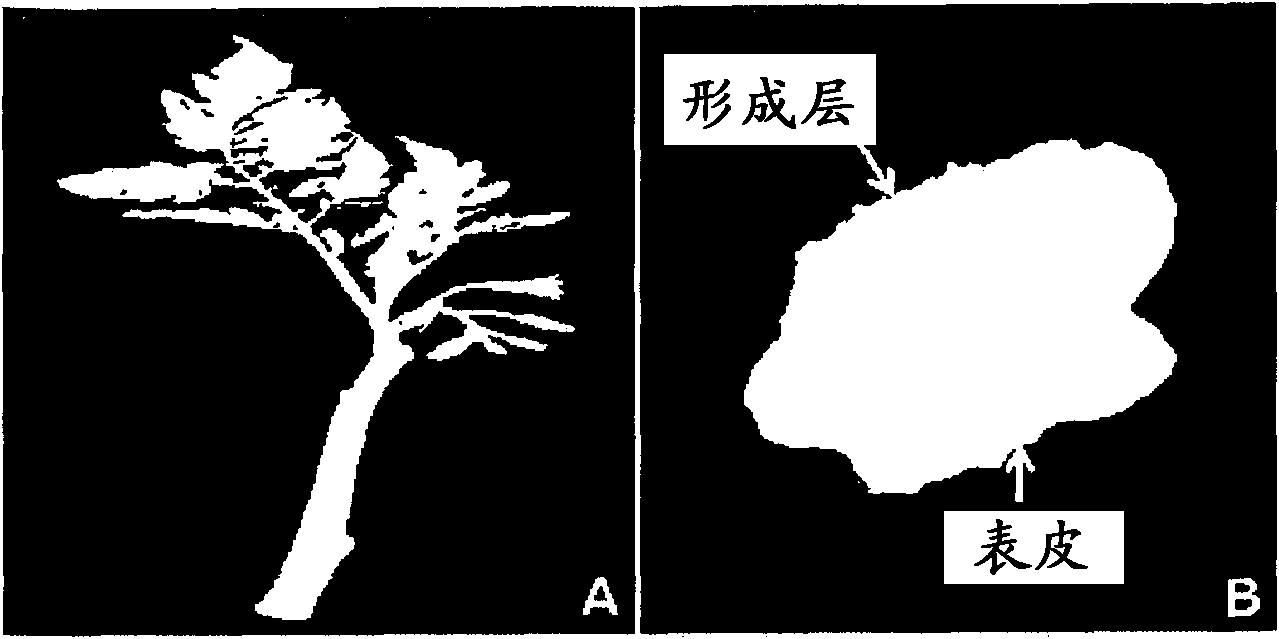Plant stem cell derived from cambium of family solanaceae, and method for isolating and culturing same
A cambium and stem cell technology, applied in plant cells, botanical equipment and methods, biochemical equipment and methods, etc., can solve problems such as high production costs, limited content of physiologically active substances, and variation
- Summary
- Abstract
- Description
- Claims
- Application Information
AI Technical Summary
Problems solved by technology
Method used
Image
Examples
Embodiment 1
[0048] [Example 1: Preparation of cambium-derived stem cells of Solanaceae]
[0049] 【1-1: Preparation of plant materials】
[0050] To harvest cambium-derived stem cells from tomato (Lycopericum esculentum, purchased from Sejong Seedlings Co., Ltd.) of the genus Solanaceae, the stem ( figure 1 A) Immediately thereafter, it was immersed in an antioxidant 100 mg / L ascorbic acid (L-ascorbic acid, DUCHEFA, TheNetherlands) solution for transport-preservation. At this time, to harvest the same stem cells for utilizing the procambium, the residual branches were collected instead of the stems.
[0051] Thereafter, in 0.1% benomyl (benomyl, Dongbu Hannong Chemical, Korea), 0.1% chlorothalonil (daconil, Dongbu Hannong Chemical, Korea), 0.1% streptomycin sulphate (sterptomycin sulphate, DUCHEFA, The Netherlands), 0.01% After pretreatment in a mixed solution of cefotaxime sodium DUCHEFA, The Netherlands for 10 minutes, they were washed with tap water for 5 minutes to remove phenolic com...
Embodiment 2
[0062] [Example 2: Proliferation and characteristic observation of stem cells derived from cambium of Solanaceae]
[0063] The cambium-derived stem cells isolated in Example 1 were put into bottles containing the following liquid medium and cultured in a shaker at 100 rpm at 25±1° C. under dark conditions. The cycle of subculture is fixed at 2 weeks, so that the cultured cells can always maintain high viability in the logarithmic growth phase.
[0064] Table 2: Suspension medium (medium 2)
[0065]
[0066] When observing the degree of cell aggregation (biological microscope C × 31, Olympus, Japan), the stem cells according to the present invention are as follows: figure 2 As shown in A, it was confirmed that a large number of single cells were included in the suspension culture, and some of them existed as cell aggregates of very small size. That is, as a result of culturing the stem cells according to the present invention, the maximum aggregate size was only 500 μm. ...
Embodiment 3
[0079] [Example 3: Preparation of extracts from cambium-derived stem cells of Solanaceae]
[0080] After harvesting the stem cells cultured in suspension for 14 days as in Example 2 and removing the culture medium, 500 ml of DMSO was added to 500 g of harvested stem cells and stirred at 50° C. for 6 hours to dissolve them. Thereafter, the supernatant was collected by centrifugation at 3,000 g for 10 minutes to obtain a DMSO-soluble substance. The obtained DMSO-soluble matter was concentrated with a rotary vacuum concentrator, and the concentrated sample was dried with a freeze dryer to obtain a DMSO extract and use it.
PUM
 Login to View More
Login to View More Abstract
Description
Claims
Application Information
 Login to View More
Login to View More - R&D
- Intellectual Property
- Life Sciences
- Materials
- Tech Scout
- Unparalleled Data Quality
- Higher Quality Content
- 60% Fewer Hallucinations
Browse by: Latest US Patents, China's latest patents, Technical Efficacy Thesaurus, Application Domain, Technology Topic, Popular Technical Reports.
© 2025 PatSnap. All rights reserved.Legal|Privacy policy|Modern Slavery Act Transparency Statement|Sitemap|About US| Contact US: help@patsnap.com



